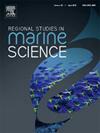Green synthesis of iron oxide nanoparticles using Momordica charantia: Kinetics of removal of heavy metal and microplastic pollutants
IF 2.1
4区 环境科学与生态学
Q3 ECOLOGY
引用次数: 0
Abstract
Microplastics (MPs) and heavy metals (HMs) have been contributing widely to global environmental pollution. Green and eco-friendly synthesis of nanoparticles can be a cost-effective and sustainable approach to protect aquatic ecosystems and human well being. Plant extract based nanoparticles offer major benefits as they are safer, economic, easy to obtain and have good reduction and stabilization potential. Moreover, the active agents in plants are safer to handle than conventional chemicals and microbes. To aid to the mentioned objective, iron oxide nanoparticles (IONPs) were synthesized from the fruit extract of Momordica charantia by coprecipitation method. The characterization studies were carried out using Scanning electron microscopy (SEM), Ultraviolet- Visible spectroscopy (UV-Vis), FTIR (Fourier Transform Infrared Spectroscopy), and XRD (X Ray Diffraction). Spherical shaped, reddish brown nanoparticles with size ranging from 50–70 nm were fabricated. The potential and kinetics of IONPs for the removal of carcinogenic HMs such as Lead (Pb), Cadmium (Cd) and selected MP polymer Polyamide (PA) were further investigated. The Kinetics and isothermal models brought an insight into the removal rates of HMs and MP pollutants. While the polyamide removal was best explained by Pseudo-first order kinetics and Langmuir isotherm; pseudo second-order kinetics and Freundlich isotherm models could fit to the adsorption process between HMs (Pb, Cd) and IONPs. The synthesized IONPs could be used up to four cycles with maximum removal potential of 91.59, 92.52 and 89.43 percent for Pb, Cd and polyamide respectively in the first cycle. In order to check the safety of nanoparticles for environmental applications, phytoxicity studies were conducted. Seeds of Vigna radiata were used to study the toxic effects of each pollutant and the synthesized IONPs on the shoot and root growth. Thus, these preliminary findings of the current study indicate that IONPs synthesized using green pathway could contribute to removal of emerging contaminations from aqueous media, and offer potential approach for water purification, pending further mechanistic investigation.
利用苦瓜绿色合成氧化铁纳米颗粒:去除重金属和微塑料污染物的动力学
微塑料(MPs)和重金属(HMs)是造成全球环境污染的主要原因。绿色和生态友好的纳米颗粒合成可以是一种具有成本效益和可持续的方法,以保护水生生态系统和人类福祉。基于植物提取物的纳米颗粒具有安全、经济、易于获得和良好的还原和稳定潜力等优点。此外,植物中的活性物质比传统的化学物质和微生物处理起来更安全。为实现上述目的,以苦瓜果实提取物为原料,采用共沉淀法合成了氧化铁纳米颗粒。采用扫描电子显微镜(SEM)、紫外-可见光谱(UV-Vis)、傅里叶变换红外光谱(FTIR)和X射线衍射(XRD)进行表征研究。制备了球形红棕色纳米颗粒,粒径在50-70 nm之间。进一步研究了IONPs去除致癌物质铅(Pb)、镉(Cd)和选定的MP聚合物聚酰胺(PA)的潜力和动力学。动力学和等温模型使我们深入了解了HMs和MP污染物的去除率。而拟一级动力学和Langmuir等温线最能解释聚酰胺的去除;拟二级动力学模型和Freundlich等温线模型适合于HMs (Pb, Cd)与离子间的吸附过程。所合成的离子可循环使用4次,对Pb、Cd和聚酰胺的最大去除率分别为91.59%、92.52%和89.43%。为了验证纳米颗粒在环境应用中的安全性,进行了植物毒性研究。以辐射豇豆种子为研究对象,研究了各污染物及其合成离子对其茎、根生长的毒性作用。因此,目前研究的这些初步发现表明,使用绿色途径合成的离子螯合物可能有助于去除水介质中新出现的污染物,并为水净化提供了潜在的方法,有待进一步的机制研究。
本文章由计算机程序翻译,如有差异,请以英文原文为准。
求助全文
约1分钟内获得全文
求助全文
来源期刊

Regional Studies in Marine Science
Agricultural and Biological Sciences-Ecology, Evolution, Behavior and Systematics
CiteScore
3.90
自引率
4.80%
发文量
336
审稿时长
69 days
期刊介绍:
REGIONAL STUDIES IN MARINE SCIENCE will publish scientifically sound papers on regional aspects of maritime and marine resources in estuaries, coastal zones, continental shelf, the seas and oceans.
 求助内容:
求助内容: 应助结果提醒方式:
应助结果提醒方式:


